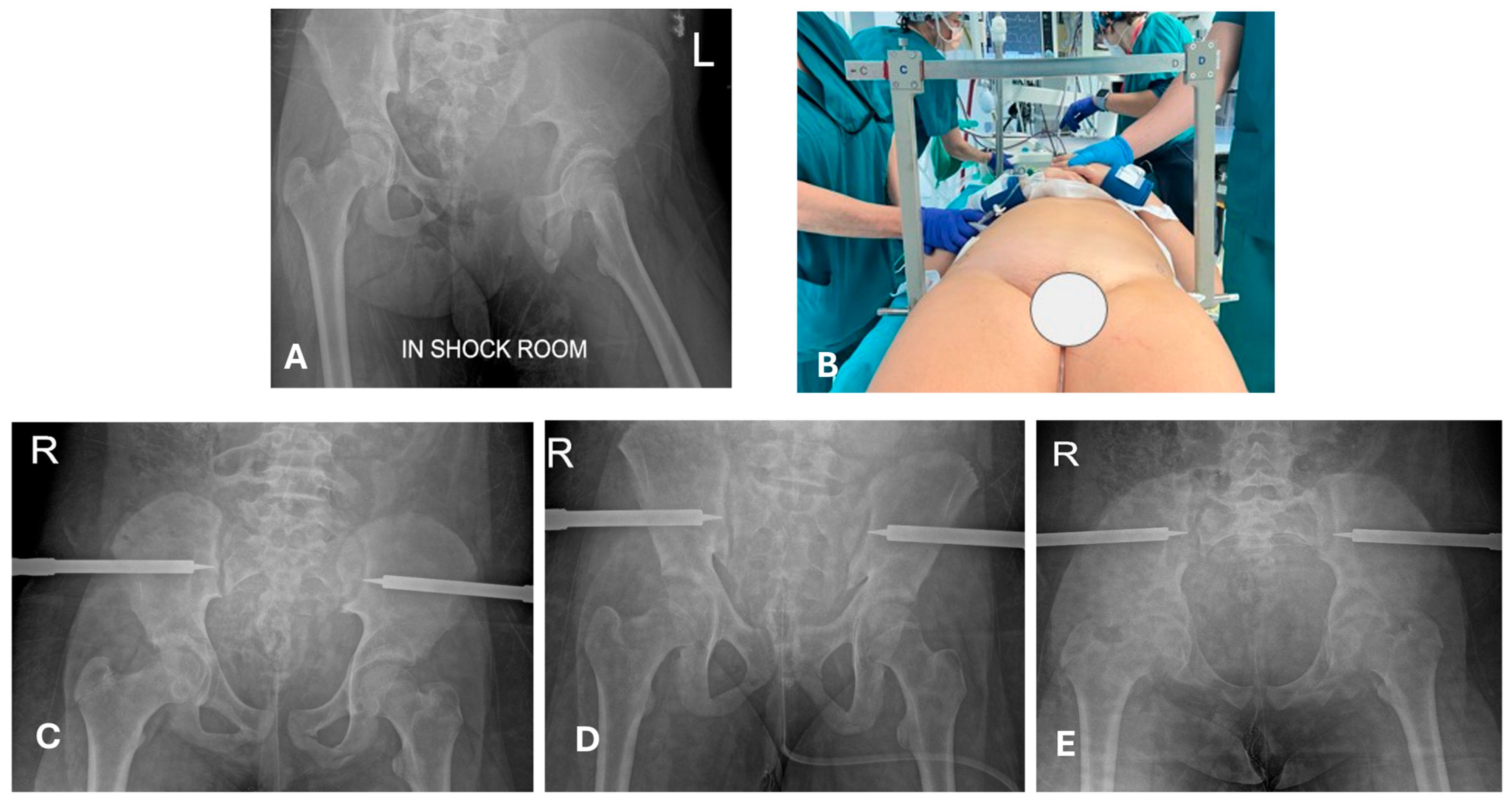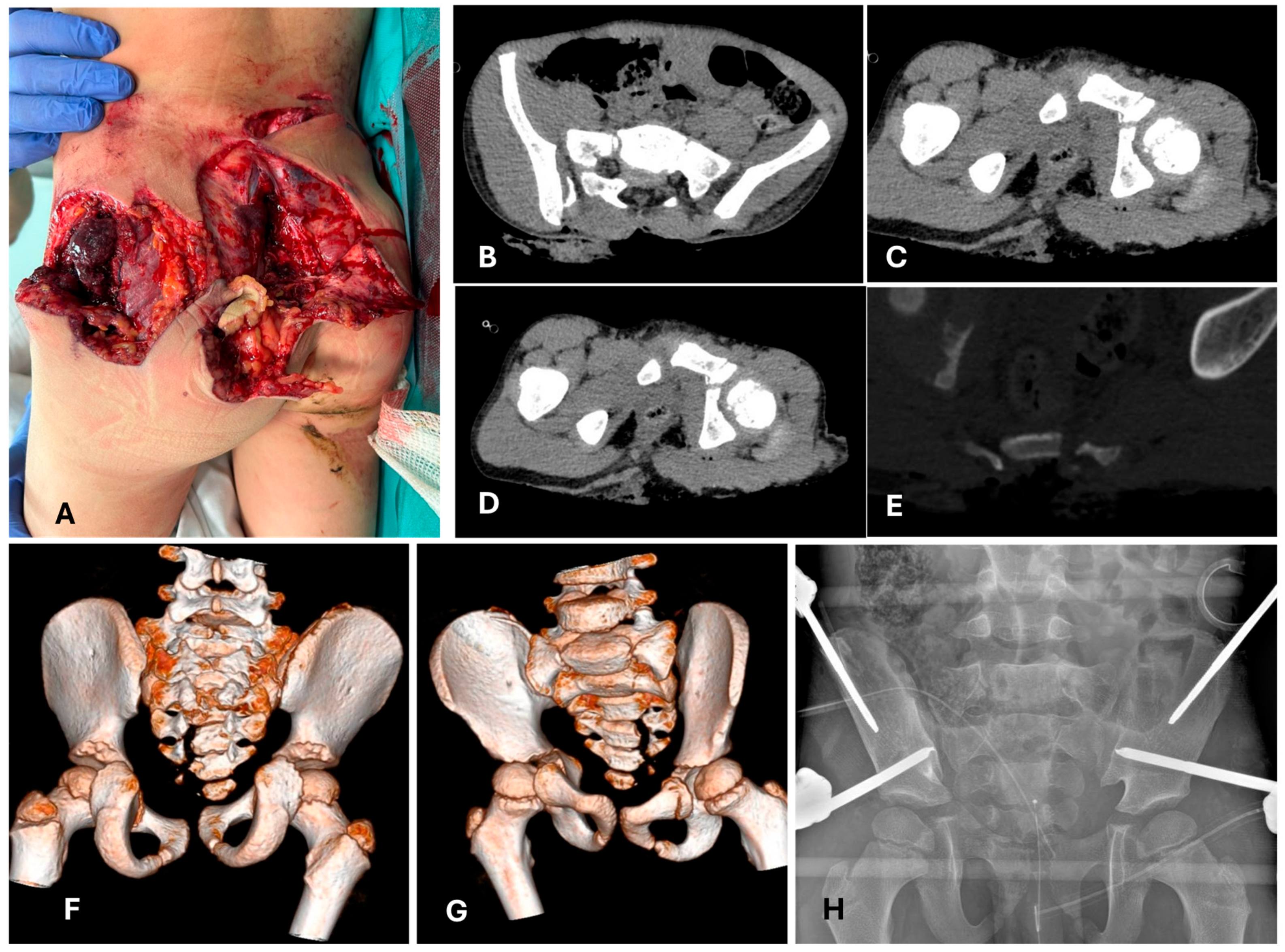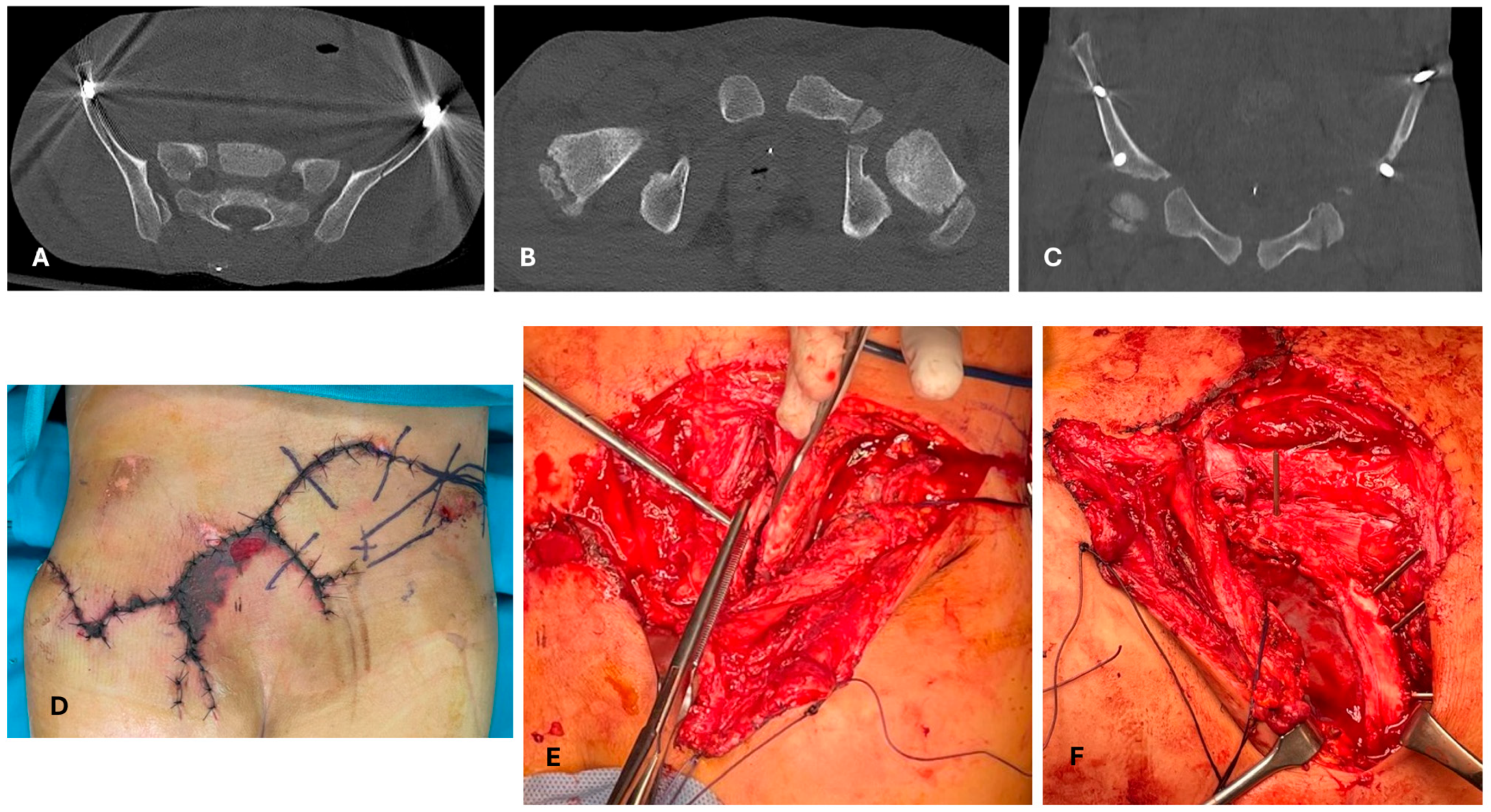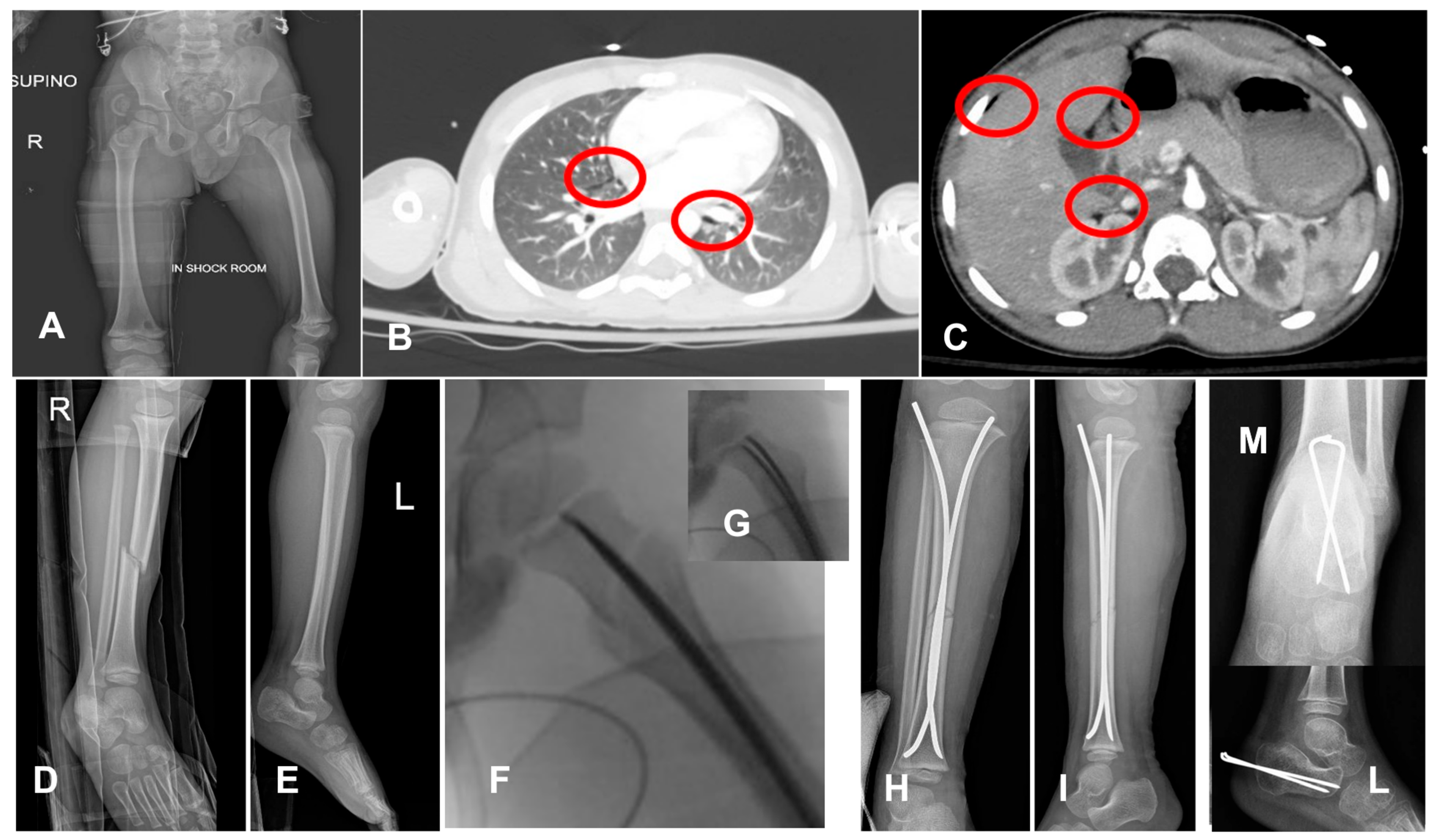The “Bergamo Approach” for Pediatric and Adolescent Polytrauma—A One-Center Experience
Abstract
1. Introduction
- A.
- Ensuring airway patency;
- B.
- Supporting adequate ventilation;
- C.
- Identifying and managing significant hemorrhage, which could be abdominal, pelvic, or intracranial.
2. Materials and Methods
- A 10-year period was chosen to analyze the diaphyseal femur fracture. Diaphyseal femur fractures were extracted as indicators of DCO versus ETC, according to the expected frequency in association with PPT and univocal classification in registers. We also chose to observe retrospectively the treatment approach (temporary external fixation or definitive treatment).
- A 4-year period (2021–2024) was chosen to describe the associated lesions of PPT, such as head injuries, thoracic and abdominal lesions, spinal lesions with or without neurological consequences, and major blood vessel lesions.
- A 1-year period was chosen to analyze the overall in-hospital mortality and admission rates in the PICU.
3. Results
- In the age-group 15–17 years, 23/23 (100%) cases were treated with temporary external fixation (ExFix);
- In the age group 12–14 years, 9/14 (64%) cases were treated with ExFix, and 5/14 (26%) cases were treated with elastic stable intramedullary nails (ESIN);
- In the age group 5–11 years, 1/5 (20%) cases were treated with ExFix, and 4 cases were treated with ESIN;
- In the age group 0–4 years, 2/4 (50%) cases were treated with ESIN, and 2/4 (50%) cases were treated with a hip spica cast.
4. Discussion
- Is emergency treatment needed? When should the fracture be fixed?
- Is a temporary damage control surgery (DCO) indicated?
- Does the PPT/PMT-patient need a different treatment method because of his/her general conditions?
4.1. Is an Emergency Fixation Needed? When Should the Fracture Be Fixed?
4.2. Is a Temporary Damage Control Surgery (DCO) Indicated?
4.3. Does the PPT/PMT Patient Need a Different Treatment Method Because of His/Her General Conditions?
5. Conclusions
Author Contributions
Funding
Institutional Review Board Statement
Informed Consent Statement
Data Availability Statement
Conflicts of Interest
Abbreviations
| ETC | Early Total Care |
| PPT | Pediatric Polytrauma |
| PMT | Pediatric Major Trauma |
| DCO | Damage Control in Orthopedics |
| ESIN | Elastic Stable Intramedullary Nail(s) |
| ExFix | External fixation |
| NICU | Neonatal Intensive Care Unit |
| PICU | Pediatric Intensive Care Unit |
| SDS | Safe Definitive Surgery |
References
- Stewart, R.M.; Rotondo, M.F.; Nathens, A.B.; Neal, M.; Caden-Price, C.; Lynch, J.; Burd, R.S.; Maxson, F.R.T.; Upperman, J.S.; Weinand, M.E.; et al. NTDB Pediatric Report 2016. 2016, 128. Available online: https://www.facs.org/quality-programs/trauma/quality/national-trauma-data-bank/ (accessed on 6 December 2024).
- Laurer, H.; Wutzler, S.; Wyen, H.; Westhoff, J.; Lehnert, M.; Lefering, R.; Marzi, I. Prä- und frühklinische versorgungsqualität pädiatrischer traumapatienten im schulalter im vergleich mit dem erwachsenenkollektiv: Matched-pair-analyse an 624 patienten aus dem traumaregister der DGU. Unfallchirurg 2009, 112, 771–777. [Google Scholar] [CrossRef]
- Hoefer, C.; Lefering, R. Annual Report 2021. Trauma Regist. DGU 2021, 1–74. Available online: www.auc-online.de (accessed on 25 February 2025).
- Sentilles, C.; Whitan, E.L.; Orand, K.J.; Naser, A.M.; Rowland, J.; Sawyer, J.R.; Sheffer, B.W.; Spence, D.D.; Wamer, W.C.; Kelly, D.M. An emerging heathcare crisis: Trends in pediatric firearm injuries over time_analysis of over 1100 cases. In “EPOS/POSNA Abstract Book”. J. Child. Orthop. 2024, 18, 1–440. [Google Scholar] [CrossRef]
- McAleese, T.; Brent, L.; O’Toole, P.; Synnott, K.; Quinn, N.; Deasy, C.; Sheehan, E. Paediatric major trauma in the setting of the Irish trauma network. Injury 2021, 52, 2233–2243. [Google Scholar] [CrossRef] [PubMed]
- Ruch, D.A.; Heck, K.M.; Sheftall, A.H.; Fontanella, C.A.; Stevens, J.; Zhu, M.; Horowitz, L.M.; Campo, J.V.; Bridge, J.A. Characteristics and precipitating circumstances of suicide among children aged 5 to 11 years in the united states, 2013–2017. JAMA Netw. Open 2021, 4, E2115683. [Google Scholar] [CrossRef] [PubMed]
- Beck, B.; Teague, W.; Cameron, P.; Gabbe, B.J. Causes and characteristics of injury in paediatric major trauma and trends over time. Arch. Dis. Child. 2019, 104, 256–261. [Google Scholar] [CrossRef]
- World Health Organization. Global Status Report on Preventing Violence Against Children 2020; WHO: Geneva, Switzerland, 2020; ISBN 9789240004191. Available online: https://apps.who.int/iris/bitstream/handle/10665/332394/9789240004191-eng.pdf%0Ahttps://www.who.int/publications-detail-redirect/9789240004191 (accessed on 6 December 2024).
- Christian, C.W.; Crawford-Jakubiak, J.E.; Flaherty, E.G.; Leventhal, J.M.; Lukefahr, J.L.; Sege, R.D. The evaluation of suspected child physical abuse. Pediatrics 2015, 135, e1337–e1354. [Google Scholar] [CrossRef]
- Narain, A.; Goldstein, M. Skeletal Manifestations of Child Maltreatment. Clin. Pediatr. Emerg. Med. 2016, 17, 274–283. [Google Scholar] [CrossRef]
- Borg, K.; Hodes, D. Guidelines for skeletal survey in young children with fractures. Arch. Dis. Child. Educ. Pract. Ed. 2015, 100, 253–256. [Google Scholar] [CrossRef]
- Loos, M.L.H.J.; van Rijn, R.R.; Krug, E.; Bloemers, F.W.; Ten Bosch, J.A.; Bossuyt, P.M.M.; Edwards, M.J.R.; Greeven, A.P.A.; Hulscher, J.B.F.; Keyzer-Dekker, C.M.G.; et al. The prevalence of non-accidental trauma among children with polytrauma: A nationwide level-I trauma centre study. J. Forensic Leg. Med. 2022, 90, 102386. [Google Scholar] [CrossRef]
- Servaes, S.; Brown, S.D.; Choudhary, A.K.; Christian, C.W.; Done, S.L.; Hayes, L.L.; Levine, M.A.; Moreno, J.A.; Palusci, V.J.; Shore, R.M.; et al. The etiology and significance of fractures in infants and young children: A critical multidisciplinary review. Pediatr. Radiol. 2016, 46, 591–600. [Google Scholar] [CrossRef]
- Aitken, M.E.; Tilford, J.M.; Barrett, K.W.; Parker, J.G.; Simpson, P.; Landgraf, J.; Robbins, J.M. Health status of children after admission for injury. Pediatrics 2002, 110, 337–342. [Google Scholar] [CrossRef]
- Janssens, L.; Gorter, J.W.; Ketelaar, M.; Kramer, W.L.M.; Holtslag, H.R. Health-related quality-of-life measures for long-term follow-up in children after major trauma. Qual. Life Res. 2008, 17, 701–713. [Google Scholar] [CrossRef]
- Gabbe, B.J.; Simpson, P.M.; Sutherland, A.M.; Palmer, C.S.; Williamson, O.D.; Butt, W.; Bevan, C.; Cameron, P.A. Functional and health-related quality of life outcomes after pediatric trauma. J. Trauma Inj. Infect. Crit. Care 2011, 70, 1532–1538. [Google Scholar] [CrossRef] [PubMed]
- Balogh, Z.J. Polytrauma: It is a disease. Injury 2022, 53, 1727–1729. [Google Scholar] [CrossRef] [PubMed]
- Eberbach, H.; Hohloch, L.; Feucht, M.J.; Konstantinidis, L.; Südkamp, N.P.; Zwingmann, J. Operative versus conservative treatment of apophyseal avulsion fractures of the pelvis in the adolescents: A systematical review with meta-analysis of clinical outcome and return to sports. BMC Musculoskelet. Disord. 2017, 18, 162. [Google Scholar] [CrossRef] [PubMed]
- Zwingmann, J.; Schmal, H.; Südkamp, N.P.; Strohm, P.C. Verletzungsschwere und -Lokalisationen Polytraumatisierter Kinder im Vergleich zu Erwachsenen und Deren Bedeutung für das Schockraummanagement Eine Retrospektive 3-Jahres-Studie. Zentralblatt Fur Chir. Z. Fur Allg. Visz. Und Gefasschir. 2008, 133, 68–75. [Google Scholar] [CrossRef]
- Kellum, E.; Creek, A.; Dawkins, R.; Bernard, M.; Sawyer, J.R. Age-related patterns of injury in children involved in all-terrain vehicle accidents. J. Pediatr. Orthop. 2008, 28, 854–858. [Google Scholar] [CrossRef]
- Monsell, F.; Sepulveda, D. Pediatric Polytrauma. AO Foundation. Available online: https://surgeryreference.aofoundation.org/orthopedic-trauma/pediatric-trauma/further-reading/pediatric-polytrauma?searchurl=%2Fsearchresults (accessed on 10 May 2024).
- Kay, R.M.; Skaggs, D.L. Pediatric polytrauma management. J. Pediatr. Orthop. 2006, 26, 268–277. [Google Scholar] [CrossRef]
- Loubani, E.; Bartley, D.; Forward, K. Orthopedic Injuries in Pediatric Trauma. Curr. Pediatr. Rev. 2018, 14, 52–58. [Google Scholar] [CrossRef]
- Zwingmann, J.; Lefering, R.; Maier, D.; Hohloch, L.; Eberbach, H.; Neumann, M.; Strohm, P.C.; Südkamp, N.P.; Hammer, T. Pelvic fractures in severely injured children. Medicine Baltim. 2018, 97, e11955. [Google Scholar] [CrossRef]
- Oransky, M.; Arduini, M.; Tortora, M.; Zoppi, A.R. Surgical treatment of unstable pelvic fracture in children: Long term results. Injury 2010, 41, 1140–1144. [Google Scholar] [CrossRef]
- Guindani, F.N.; Chiodini, J.; Waldner, M.D.P. Kinder- und Jugendlichen diaphysäre Femuschaftfrakturen. In Behandlungsoptionen Nach Alter und Fraktur; VKO Kongress_Abstract book_in Press: Münster, Germany, 2024. [Google Scholar]
- Valaikaite, R.; Tabard-Fougère, A.; Steiger, C.; Samara, E.; Dayer, R.; Ceroni, D. A retrospective epidemiological study of paediatric femoral fractures. Swiss Med. Wkly. 2020, 150, w20360. [Google Scholar] [CrossRef]
- Bohndorf, K.; Beckmann, J.; Jäger, M.; Kenn, W.; Maus, U.; Nöth, U.; Peters, K.M.; Rader, C.; Reppenhagen, S.; Roth, A. S3-Leitline. Teil 1: Diagnostik und Differenzialdiagnostik der atraumatischen Femurkopfnekrose (aFKN) des Erwachsenen. Z. Orthop. Unfall. 2015, 153, 375–386. [Google Scholar] [CrossRef]
- Difino, M.; Stucchi, R.; Weinstein, E.S.; De Pellegrin, M.; Zoli, A.; Sechi, G.M.; Faccincani, R. What If Nice Terrorist Attack Would Have Happened in Milan? Drawing a Disaster Plan for Mass Casualty Incidents Involving the Pediatric Population. Disaster Med. Public Health Prep. 2024, 18, e94. [Google Scholar] [CrossRef]
- Webman, R.B.; Carter, E.A.; Mittal, S.; Wang, J.; Sathya, C.; Nathens, A.B.; Nance, M.L.; Madigan, D.; Burd, R.S. Association between trauma center type and mortality among injured adolescent patients. JAMA Pediatr. 2016, 170, 780–786. [Google Scholar] [CrossRef] [PubMed]
- Potoka, D.A.; Schall, L.C.; Gardner, M.J.; Stafford, P.W.; Peitzman, A.B.; Ford, H.R. Impact of pediatric trauma centers on mortality in a statewide system. J. Trauma Inj. Infect. Crit. Care 2000, 49, 237–245. [Google Scholar] [CrossRef] [PubMed]
- Potoka, D.A.; Schall, L.C.; Ford, H.R.; Wesson, D.; Rozycki, G.; Sartorelli, K.; Hammond, J.; Cooper, A. Improved functional outcome for severely injured children treated at pediatric trauma centers. J. Trauma Inj. Infect. Crit. Care 2001, 51, 824–834. [Google Scholar] [CrossRef] [PubMed]
- Dreyfus, J.; Flood, A.; Cutler, G.; Ortega, H.; Kreykes, N.; Kharbanda, A. Comparison of pediatric motor vehicle collision injury outcomes at Level I trauma centers. J. Pediatr. Surg. 2016, 51, 1693–1699. [Google Scholar] [CrossRef]
- Pracht, E.E.; Tepas, J.J.; Langland-Orban, B.; Simpson, L.; Pieper, P.; Flint, L.M. Do pediatric patients with trauma in Florida have reduced mortality rates when treated in designated trauma centers? J. Pediatr. Surg. 2008, 43, 212–221. [Google Scholar] [CrossRef]
- Notrica, D.M.; Weiss, J.; Garcia-Filion, P.; Kuroiwa, E.; Clarke, D.; Harte, M.; Hill, J.; Moffat, S. Pediatric trauma centers: Correlation of ACS-verified trauma centers with CDC statewide pediatric mortality rates. J. Trauma Acute Care Surg. 2012, 73, 566–572. [Google Scholar] [CrossRef]
- Inaba, A.S.; Seward, P.N. An approach to pediatric trauma: Unique anatomic and pathophysiologic aspects of the pediatric patient. Emerg. Med. Clin. N. Am. 1991, 9, 523–548. [Google Scholar] [CrossRef]
- Stewart, R.M.; Rotondo, M.F.; Henry, S.M.; Drago, M.; Merrick, C.; Haskin, D.S.; Peterson, N.; Kidd, S.; Menendez, A.; Flor, R.; et al. Advanced Trauma Life Support: Student Course Manual, 10th ed.; American College of Surgeons: Boston, MA, USA, 2018; ISBN 78-0-9968262-3-5. [Google Scholar]
- Gwinnutt, C.L.; Driscoll, P. Advanced Trauma Life Support; American College of Surgeons: Boston, MA, USA, 1993; Volume 48, pp. 441–442. ISBN 7809968262. [Google Scholar]
- Carter, E.A.; Waterhouse, L.J.; Kovler, M.L.; Fritzeen, J.; Burd, R.S. Adherence to ATLS primary and secondary surveys during pediatric trauma resuscitation. Resuscitation 2013, 84, 66–71. [Google Scholar] [CrossRef] [PubMed]
- Russell, K.; Biswas, S. Pediatric trauma center vs. adult trauma center: Which is better? Curr. Opin. Anaesthesiol. 2023, 36, 159–162. [Google Scholar] [CrossRef] [PubMed]
- Oyetunji, T.A.; Haider, A.H.; Downing, S.R.; Bolorunduro, O.B.; Efron, D.T.; Haut, E.R.; Chang, D.C.; Cornwell, E.E.; Abdullah, F.; Siram, S.M. Treatment outcomes of injured children at adult level 1 trauma centers: Are there benefits from added specialized care? Am. J. Surg. 2011, 201, 445–449. [Google Scholar] [CrossRef]
- Moore, L.; Freire, G.; Turgeon, A.F.; Bérubé, M.; Boukar, K.M.; Tardif, P.A.; Stelfox, H.T.; Beno, S.; Lauzier, F.; Beaudin, M.; et al. Pediatric vs. Adult or Mixed Trauma Centers in Children Admitted to Hospitals Following Trauma: A Systematic Review and Meta-Analysis. JAMA Netw. Open 2023, 6, e2334266. [Google Scholar] [CrossRef]
- Bouzat, P.; Broux, C.; Ageron, F.X.; Thony, F.; Arvieux, C.; Tonetti, J.; Gay, E.; Rancurel, E.; Payen, J.F. Trauma network for severely injured patients. Ann. Françaises Anesthésie Réanimation 2013, 32, 531–534. [Google Scholar] [CrossRef]
- Williams, M.J.; Lockey, A.S.; Culshaw, M.C. Improved trauma management with advanced trauma life support (ATLS) training. Emerg. Med. J. 1997, 14, 81–83. [Google Scholar] [CrossRef]
- G, P. Decreto N. 7289 Della Regione Lombardia, per la Gestione del Trauma Maggiore; Regione Lombardia: Milano, Italy, 2023. [Google Scholar]
- Van Olden, G.D.J.; Dik Meeuwis, J.; Bolhuis, H.W.; Boxma, H.; Goris, R.J.A. Clinical impact of advanced trauma life support. Am. J. Emerg. Med. 2004, 22, 522–525. [Google Scholar] [CrossRef]
- Degenhardt, P.; Kleber, C.; Bail, H.J. Emergencies in pediatric traumatology–fractures in the growing age and pediatric polytrauma. Anasthesiologie Intensiv. Notfallmedizin Schmerzther. 2009, 44, 19526450. [Google Scholar] [CrossRef]
- Gupta, B.; Farooque, K. Early total care to early appropriate care—What every anesthesiologist must know! J. Anaesthesiol. Clin. Pharmacol. 2023, 39, 3–10. [Google Scholar] [CrossRef]
- Pfeifer, R.; Klingebiel, F.K.L.; Halvachizadeh, S.; Kalbas, Y.; Pape, H.C. How to Clear Polytrauma Patients for Fracture Fixation: Results of a systematic review of the literature. Injury 2023, 54, 292–317. [Google Scholar] [CrossRef]
- Buschmann, C.; Kühne, C.A.; Lösch, C.; Nast-Kolb, D.; Ruchholtz, S. Major trauma with multiple injuries in German children: A retrospective review. J. Pediatr. Orthop. 2008, 28, 1–5. [Google Scholar] [CrossRef] [PubMed]
- Eldredge, R.S.; Ochoa, B.; Notrica, D.; Lee, J. National Management Trends in Pediatric Splenic Trauma—Are We There yet? J. Pediatr. Surg. 2024, 59, 320–325. [Google Scholar] [CrossRef] [PubMed]
- Curtis, K.; McCarthy, A.; Mitchell, R.; Black, D.; Foster, K.; Jan, S.; Burns, B.; Tall, G.; Rigby, O.; Gruen, R.; et al. Paediatric trauma systems and their impact on the health outcomes of severely injured children: Protocol for a mixed methods cohort study. Scand. J. Trauma. Resusc. Emerg. Med. 2016, 24, 69. [Google Scholar] [CrossRef] [PubMed]
- Ross, S.W.; Campion, E.; Jensen, A.R.; Gray, L.; Gross, T.; Namias, N.; Goodloe, J.M.; Bulger, E.M.; Fischer, P.E.; Fallat, M.E. Prehospital and emergency department pediatric readiness for injured children: A statement from the American College of Surgeons Committee on Trauma Emergency Medical Services Committee. J. Trauma Acute Care Surg. 2023, 95, E6–E10. [Google Scholar] [CrossRef]
- Ageron, F.X.; Debaty, G.; Savary, D.; Champly, F.; Albasini, F.; Usseglio, P.; Vallot, C.; Galvagno, S.; Bouzat, P.; Bouzat, P.; et al. Association of helicopter transportation and improved mortality for patients with major trauma in the northern French Alps trauma system: An observational study based on the TRENAU registry. Scand. J. Trauma Resusc. Emerg. Med. 2020, 28, 12–13. [Google Scholar] [CrossRef]
- Studnek, J.R.; Lerner, E.B.; Shah, M.I.; Browne, L.R.; Brousseau, D.C.; Cushman, J.T.; Dayan, P.S.; Drayna, P.C.; Drendel, A.L.; Gray, M.P.; et al. Consensus-based Criterion Standard for the Identification of Pediatric Patients Who Need Emergency Medical Services Transport to a Hospital with Higher-level Pediatric Resources. Acad. Emerg. Med. 2018, 25, 1409–1414. [Google Scholar] [CrossRef]
- Lerner, E.B.; Drendel, A.L.; Cushman, J.T.; Badawy, M.; Shah, M.N.; Guse, C.E.; Cooper, A. Ability of the Physiologic Criteria of the Field Triage Guidelines to Identify Children Who Need the Resources of a Trauma Center. Prehospital Emerg. Care 2017, 21, 180–184. [Google Scholar] [CrossRef]
- Wallis, L.A.; Carley, S. Comparison of paediatric major incident primary triage tools. Emerg. Med. J. 2006, 23, 475–478. [Google Scholar] [CrossRef]
- Callaway, D.W.; Smith, E.R.; Cain, J.; Shapiro, G.; Burnett, W.T.; McKay, S.D.; Mabry, R. Tactical emergency casualty care (TECC): Guidelines for the provision of prehospital trauma care in high threat environments. J. Spec. Oper. Med. 2011, 11, 104–122. [Google Scholar] [CrossRef]
- Deutsche Gessellschaft für Kinderchirurgie. S2—Leitlinie Polytraumaversorgung im Kindesalter; AWMF: Marburg, Germany, 2020. [Google Scholar]
- Auner, B.; Jakob, H.; Marzi, I. Das schwer verletzte Kind. Orthopädie und Unfallchirurgie Up2date 2016, 11, 305–326. [Google Scholar] [CrossRef]
- Rapp, M.; Kaiser, M.M.; Grauel, F.; Gielok, C.; Illing, P. Femoral shaft fractures in young children (<5 years of age): Operative and non-operative treatments in clinical practice. Eur. J. Trauma Emerg. Surg. 2016, 42, 719–724. [Google Scholar] [CrossRef] [PubMed]
- Wood, J.H.; Partrick, D.A.; Johnston, R.B. The inflammatory response to injury in children. Curr. Opin. Pediatr. 2010, 22, 315–320. [Google Scholar] [CrossRef] [PubMed]
- Calkins, C.M.; Bensard, D.; Moore, E.; McIntyre, R.C.; Silliman, C.; Biffl, W.; Harken, A.H.; Partrick, D.A.; Offner, P.J. The injured child is resistant to multiple organ failure: A different inflammatory response? J. Trauma 2002, 53, 1058–1063. [Google Scholar] [CrossRef] [PubMed]
- Anari, J.B.; Hosseinzadeh, P.; Herman, M.J.; Eberson, C.P.; Baldwin, K.D. Pediatric Polytrauma: What Is the Role of Damage Control Orthopaedics in the Pediatric Population? Instr. Course Lect. 2019, 68, 337–346. [Google Scholar]
- Pfeifer, R.; Sellei, R.; Pape, H.C. The biology of intramedullary reaming. Injury 2010, 41 (Suppl. 2), S4–S8. [Google Scholar] [CrossRef]
- De Pellegrin, M.; Marcucci, L.; Drossinos, A.M.D. External fixation or intramedullary nailing in lower limb fractures in children in mass casualty incidents? Eur. J. Trauma Emerg. Surg. 2020, 46, 3–316. [Google Scholar] [CrossRef]
- Pape, H.C.; Andruszkow, H.; Pfeifer, R.; Hildebrand, F.; Barkatali, B.M. Options and hazards of the early appropriate care protocol for trauma patients with major fractures: Towards safe definitive surgery. Injury 2016, 47, 787–791. [Google Scholar] [CrossRef]
- Pfeifer, R.; Kalbas, Y.; Coimbra, R.; Leenen, L.; Komadina, R.; Hildebrand, F.; Halvachizadeh, S.; Akhtar, M.; Peralta, R.; Fattori, L.; et al. Indications and interventions of damage control orthopedic surgeries: An expert opinion survey. Eur. J. Trauma Emerg. Surg. 2021, 47, 2081–2092. [Google Scholar] [CrossRef]
- Pandya, N.K.; Upasani, V.V.; Kulkarni, V.A. The pediatric polytrauma patient: Current concepts. J. Am. Acad. Orthop. Surg. 2013, 21, 170–179. [Google Scholar] [CrossRef]
- Guo, M.; Su, Y. Risk factors for refracture of the femoral shaft in children after removal of external fixation. J. Orthop. Traumatol. 2021, 22, 4. [Google Scholar] [CrossRef]
- Zhang, Y.T.; Jin, D.; Niu, J.; Li, Z.J.; Fu, S.; Zou, Z.L. A meta-Analysis of external fixation and flexible intramedullary nails for femoral fractures in children. Acta Orthop. Belg. 2016, 82, 673–680. [Google Scholar]
- Lascombes, P.; Haumont, T.; Journeau, P. Use and abuse of flexible intramedullary nailing in children and adolescents. J. Pediatr. Orthop. 2006, 26, 827–834. [Google Scholar] [CrossRef]
- Berger, P.; De Graaf, J.S.; Leemans, R. The use of elastic intramedullary nailing in the stabilisation of paediatric fractures. Injury 2005, 36, 1217–1220. [Google Scholar] [CrossRef] [PubMed]
- Ligier, J.N.; Metaizeau, J.P.; Prevot, J.; Lascombes, P. Elastic stable intramedullary nailing of femoral shaft fractures in children. J. Bone Jt. Surg. Ser. B 1988, 70, 74–77. [Google Scholar] [CrossRef] [PubMed]
- Dietz, H.G.; Schmittenbecher, P.P.; Slongo, T.W.K. Elastic Stable Intramedullary Nailing (ESIN) in Children; AO Manual of Fracture Management Series; Thieme Medical Pub: New York, NY, USA, 2006; ISBN 978-1588904850. [Google Scholar]
- Bar-On, E.; Lebel, E.; Blumberg, N.; Sagi, R.; Kreiss, Y. Pediatric orthopedic injuries following an earthquake: Experience in an acute-phase field hospital. J. Trauma Nurs. 2015, 22, 223–228. [Google Scholar] [CrossRef] [PubMed]
- Morelli, I.; Sabbadini, M.G.; Bortolin, M. Orthopedic injuries and their treatment in children during earthquakes: A systematic review. Prehosp. Disaster Med. 2015, 30, 478–485. [Google Scholar] [CrossRef]
- Auner, B.; Marzi, I. Polytrauma des Kindes. Chirurg 2014, 85, 451–464. [Google Scholar] [CrossRef]






| Pediatric Trauma Score (PTS) | +2 | +1 | −1 |
|---|---|---|---|
| Weight | >20 kg | 10–20 kg | <10 kg |
| Airway | Patent | Maintainable | Unmaintainable |
| Systolic blood pressure | >90 mmHg | 50–90 mmHg | <50 mmHg |
| Central nervous system | Awake | Obtunded/Loss of consciousness | Unresponsive |
| Fractures | None | Closed or suspected | Multiple (closed or open) |
| Wounds | None | Minor | Major, penetrating or burns |
Disclaimer/Publisher’s Note: The statements, opinions and data contained in all publications are solely those of the individual author(s) and contributor(s) and not of MDPI and/or the editor(s). MDPI and/or the editor(s) disclaim responsibility for any injury to people or property resulting from any ideas, methods, instructions or products referred to in the content. |
© 2025 by the authors. Licensee MDPI, Basel, Switzerland. This article is an open access article distributed under the terms and conditions of the Creative Commons Attribution (CC BY) license (https://creativecommons.org/licenses/by/4.0/).
Share and Cite
Guindani, N.; Cheli, M.; Ferrari, D.; Colombo, G.; Bonanomi, E.; Chiodini, F.; De Pellegrin, M. The “Bergamo Approach” for Pediatric and Adolescent Polytrauma—A One-Center Experience. Children 2025, 12, 1194. https://doi.org/10.3390/children12091194
Guindani N, Cheli M, Ferrari D, Colombo G, Bonanomi E, Chiodini F, De Pellegrin M. The “Bergamo Approach” for Pediatric and Adolescent Polytrauma—A One-Center Experience. Children. 2025; 12(9):1194. https://doi.org/10.3390/children12091194
Chicago/Turabian StyleGuindani, Nicola, Maurizio Cheli, Daniela Ferrari, Giovanna Colombo, Ezio Bonanomi, Federico Chiodini, and Maurizio De Pellegrin. 2025. "The “Bergamo Approach” for Pediatric and Adolescent Polytrauma—A One-Center Experience" Children 12, no. 9: 1194. https://doi.org/10.3390/children12091194
APA StyleGuindani, N., Cheli, M., Ferrari, D., Colombo, G., Bonanomi, E., Chiodini, F., & De Pellegrin, M. (2025). The “Bergamo Approach” for Pediatric and Adolescent Polytrauma—A One-Center Experience. Children, 12(9), 1194. https://doi.org/10.3390/children12091194








